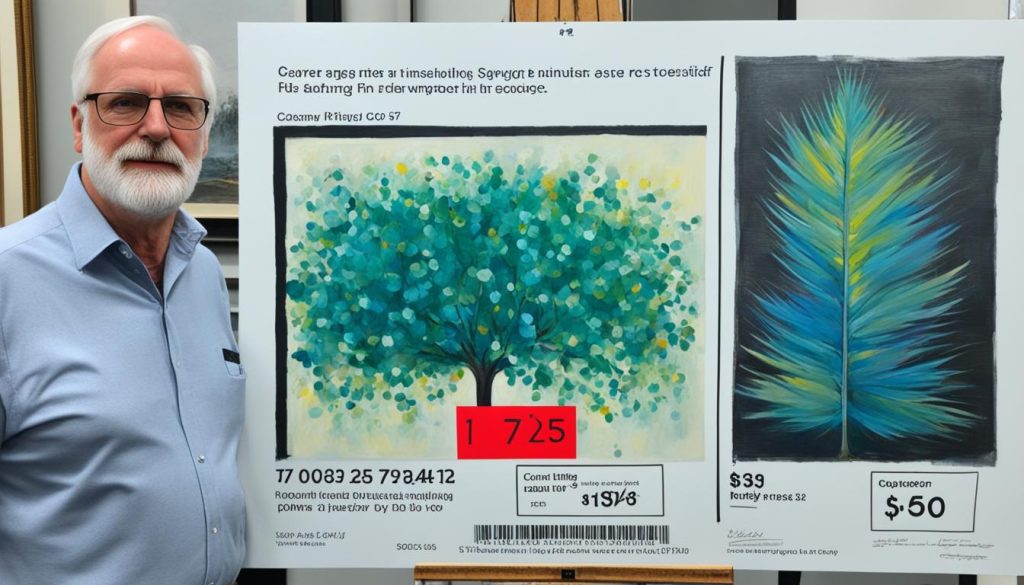Hello, fellow artists! As a creative individual, pricing your artwork can be a challenging task. Not only do you want to ensure profitability, but you also want to attract buyers who value your unique creations. In this article, I will share valuable insights and strategies on how to effectively price your art, taking into account the costs involved, industry standards, and your market value.
Key Takeaways:
- Understanding your costs is crucial for setting the right price for your art.
- Use a consistent pricing formula to accurately account for your expenses and ensure a fair profit margin.
- Consider factors like emerging artist status and market comparisons when determining your prices.
- Offering different price points can attract a broader range of collectors and diversify your revenue streams.
- Keep track of your sales history to showcase the success and value of your artwork.
Know Your Costs
Understanding art costs is crucial when it comes to pricing your artwork. To ensure profitability and fair compensation, it’s important to consider all expenses associated with creating and selling your art.
First and foremost, take into account the cost of materials. Whether you work with paints, clay, or other mediums, the price of supplies should be factored into your pricing equation. Additionally, don’t forget about expenses related to shipping and framing. These costs can add up quickly and should be incorporated into the final price of your artwork.
Another often overlooked cost is your time. As an artist, your time is valuable and should be treated as a line item cost. Consider how many hours you spend on each piece and calculate an appropriate hourly rate to include in your pricing formula.
“By accounting for all costs, you ensure fair compensation and profitability.”
By accounting for all of these costs, you guarantee that your pricing reflects the true value of your artwork. It enables you to cover your expenses and make a profit, ensuring that you’re compensated fairly for your time, talent, and materials.
In the next section, we’ll explore the importance of using a consistent formula when pricing your art.
Use a Consistent Formula
When it comes to pricing your art, using a consistent formula is key. This approach helps you accurately account for costs and ensures that your prices are fair and transparent. Two popular methods that artists often rely on are the hourly wage method and the square inches method.
The hourly wage method involves adding your hourly rate to the cost of materials. This way, you can factor in the time and effort you put into creating each piece of art. By valuing your time, you ensure that you are being appropriately compensated for your hard work.
On the other hand, the square inches method calculates the price of your art based on the total square inches of the piece. You multiply the square inches by a specific dollar amount, which you determine based on market rates and the value you assign to your art.
Both methods have their merits, and the choice ultimately depends on your preferences and business goals. The hourly wage method allows you to account for your time and effort, while the square inches method provides a standardized approach based on the physical size of your art.
Whichever formula you choose, make sure it covers your costs and provides a fair profit margin. You want your pricing to accurately reflect the value of your art while still being attractive to potential buyers. Consistency is key, as it helps to establish trust and transparency in your pricing strategy.
What to Keep In Mind
When it comes to pricing your art, using a consistent formula is essential. However, there are additional factors to consider to ensure your prices align with market trends and buyer affordability.
Factors Influencing Art Prices
Emerging artists may need to adjust their prices initially to build recognition and attract buyers. Researching the prices of artists in your area with similar styles and accomplishments can help you avoid outpricing potential buyers.
Adjusting Prices for Market Comparisons
Market comparisons play a significant role in determining the value of your art. Keep an eye on the prices of artists whose work is similar to yours. If their prices are significantly higher or lower, it may be necessary to reevaluate and adjust your own prices accordingly.
Striking a Balance
It’s crucial to find a balance between profitability and buyer affordability. While you want to ensure you’re adequately compensated for your time and talent, pricing your art too high can deter potential buyers. By considering these factors and making necessary adjustments, you can find the sweet spot that benefits both you and your collectors.
“Finding the right price for your art is an ongoing process. It’s important to stay informed about market trends and be willing to make adjustments when necessary.”
To illustrate the significance of these factors, let’s take a look at a practical example:
- An emerging artist, Sarah Thompson, recently started selling her artwork in local galleries. She used a pricing formula that considered her costs and profit margin but realized her prices were higher compared to other artists with similar styles.
- After conducting market research, Sarah discovered that the local art market primarily consisted of buyers who were just beginning to invest in original artwork. Their affordability range was limited.
- By adjusting her pricing strategy and offering more competitive prices, Sarah found that she attracted more collectors and quickly established a loyal customer base.
By keeping these factors in mind and regularly assessing your pricing strategy, you can ensure your art remains accessible to buyers while still providing a fair return on your investment of time, materials, and talent.

Consider Different Price Points
When it comes to selling your art, offering different price points can be a game-changer. Not every potential collector can afford high-end, expensive pieces. By diversifying your pricing strategy, you increase your chances of making sales and appeal to a broader range of art enthusiasts.
Alongside your higher-priced art, consider introducing more affordable options. These pieces can be less time-consuming for you to create and offer collectors a more accessible entry point into your work. While the profits from these smaller sales may seem modest individually, they can accumulate over time and provide a steady revenue stream.
“Introducing affordable art options is like opening the door to a whole new audience. It allows people who may not be able to invest in higher-priced pieces to still experience and appreciate your art.” – Emily Davis, Professional Artist
The introduction of affordable art options also helps you connect with new collectors who may develop a passion for your work over time. As these collectors gain confidence in your artistic skills and reputation, they may eventually become willing to invest in more expensive pieces.
Diversifying your revenue streams is another advantage of offering multiple price points. By catering to different buyer preferences, you can tap into various markets and increase your overall sales potential. This not only ensures a wider audience for your art but also helps cover your expenses and maintain consistent revenue throughout your art career.
To showcase the variety in your art and emphasize the different price points, consider creating a dedicated section on your website or in your gallery to display these options. This allows collectors to navigate through your art offerings more easily and make informed decisions based on their budget and preferences.
Remember, offering different price points not only benefits your collectors but also helps you as an artist. It allows you to reach a broader audience and establish a sustainable business model with multiple revenue streams.

Be Able to Show Your Comparable Sales History
Demonstrating your sales history is a powerful way to instill confidence in potential buyers and justify your art prices. Just like galleries present documentation of an artist’s provenance, collectors value evidence of an artist’s success. By keeping meticulous records of your sales and maintaining an inventory, you can easily showcase your past achievements and track record.
Presenting your sales history not only provides social proof but also serves as a form of documentation. It shows that your artwork has resonated with buyers and gives credibility to your artistic journey. This social proof can go a long way in convincing potential collectors of the value and quality of your art.
When showcasing your comparable sales history, emphasize successful transactions and highlight any notable achievements, such as pieces that sold at a premium or were acquired by prestigious collectors. By providing concrete examples of your sales track record, you give potential buyers a glimpse into your artistic success and establish a sense of trust.
One effective way to present your sales history is by creating a portfolio or catalog. This can be in digital or physical form, depending on your preferred medium. Include images of your sold artworks alongside relevant details such as the title, sale price, and the date of the transaction. Being able to visually showcase your art and its sales history adds another layer of credibility and professionalism.
Remember, comparable sales history demonstrates that your artwork has resonated with buyers, adding value to your art. It’s no different from a successful track record in any industry; it instills trust and confidence in potential buyers.
Providing comparable sales history is particularly crucial when targeting potential buyers who may be collectors or investors with a discerning eye. They rely on past sales data to evaluate an artist’s market value and determine the potential return on their investment. By documenting and presenting your sales history, you provide these buyers with valuable information that can help them make informed purchasing decisions.
As an artist, your sales history serves as a testament to your talent and the demand for your work. Utilizing it effectively can enhance your reputation, differentiate you from other artists, and increase your chances of making sales. So, make sure to document and present your sales history with pride, knowing that it carries the weight of social proof and serves as a tangible reflection of your artistic journey.
Increase Your Price Point After a Proven Track Record
Once you have established a proven track record as an artist, it may be time to consider raising your prices. This decision should be based on several factors such as measuring demand, selling success, and the overall value of your work.
If more than half of your inventory consistently sells within a short timeframe, it indicates a strong demand for your art. This is a positive sign that collectors appreciate and value your work. It demonstrates that you have developed a loyal customer base and that there is a market for your art at higher price points.
When increasing your prices, it is important to do so gradually and strategically. An annual increase of 10-20% is generally considered reasonable and allows you to maintain a balance between profitability and customer satisfaction. By incrementally raising your prices, you can capitalize on your growing reputation and ensure that your art is priced in line with its perceived value.
However, it’s crucial to regularly assess your pricing strategy to ensure it aligns with market trends and customer preferences. Keep track of your sales, monitor the feedback from collectors, and stay informed about the market value of similar artworks. This will help you strike the right balance between demand, profitability, and customer affordability.
Remember, raising prices not only reflects the growth of your artistic career, but it also positions your art as valuable and desirable. It’s an important step towards establishing yourself as a successful and sought-after artist.
“Increasing my prices after a proven track record was a game-changer for my art career. It not only gave me confidence in the value of my work but also attracted higher-profile collectors who saw the investment potential. Balancing customer demand with profitability has been crucial to my continued growth as an artist.” – Amelia Rodriguez, Contemporary Artist
Key Takeaways:
- Establishing a proven track record allows you to consider raising your prices.
- Measuring demand and selling success indicates a strong market for your art.
- Gradually increasing prices by 10-20% annually maintains a balance between profitability and customer satisfaction.
- Regularly assessing your pricing strategy and staying informed about market trends is essential.
- Raising prices reflects the growth of your artistic career and positions your art as valuable and desirable.
Conclusion
Pricing your art effectively is essential for ensuring profitability and driving sales. As an artist, it’s crucial to understand the costs associated with creating and selling your artwork, including materials, shipping, framing, and your valuable time. By accurately accounting for these costs and using a consistent pricing formula, you can set prices that reflect the true value of your work.
Consider market factors such as emerging artist status and comparisons with similar artists to find the right price point. Offering different price points can attract a wider range of collectors and increase your chances of making sales. Don’t forget to leverage your sales history as social proof of your success. Presenting evidence of past sales can help build trust and confidence in your artwork’s value.
Additionally, it’s crucial to regularly assess and adjust your prices as your career and market recognition grow. As you establish a proven track record, you can consider raising your prices to reflect the increasing demand for your work. By balancing profitability with buyer affordability, you can continue to thrive as an artist and grow your art business.
FAQ
How can I determine the price of my art?
Do I need to offer different price points for my art?
How can I justify my art prices to potential buyers?
When should I consider raising the prices of my art?
What factors should I keep in mind when pricing my art?
Share this content:






